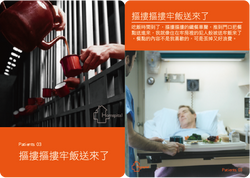
Homspital
Homspital
Year
Jan 2012
What I did
-
User research
-
User experience and service design
-
User interface design
-
Video and production
-
Product design
-
Exhibition space design
Creating the warmest Hospital Experience
During my last year at university, my father got cancer. I felt devastated and very shock. In that experience, I felt patient and their family had many uncomfortable experience in the ward. I wanted to help them to create a fearlessness experience. Then I got inspire by this difficult time then I chose this topic.
The research can be separated to two stages. In the first stage, field observation has been conducted to discover the current problems and needs in hospital. This research cooperated with Scenario lab, Shuang Ho Hospital and Taipei Veterans General Hospital. In the second stage, several issues were selected as design directions, related literature and works were also reviewed. There are four final design works which can be categorized into three aspects: clothing, eating and living.
Nowadays, with the rapid developing medial technology, people have greater opportunities to receive better health care service. To hospital residents, including patients and their families, the hospital is just like their home, which the living style in the hospital is similar to hotel or even short-term rental apartment. When living space and medical environment overlapping, the living quality could affect both residents’ mental and physical status. However, the difference feelings between hospital, home and many unfamiliar medical devices make patients uncomfortable and not adapted to the medical environment during hospitalization.

Hospital Like Home Will Become Homspital
This design research is focusing on general hospital, people who living in hospital for treatment is our target user. We could understand and uncover patients’ and their families’ problems of the current medial environment through this design research. The design research results become positive design strategies in three aspects, including clothing, eating and living, which might turn patients’ feelings of fear and anxiety into comfort and happiness. The living quality of medical environment could also be improved.
The design research can be separated to two stages. In the first stage, field observation has been conducted to discover the current problems and needs in hospital. Then using the findings from the observation as a basis to interview various people involved in the hospital environment, including the medical crew, patients and their families to understand the severity and urgent of their problems and needs. All the data collected from the observations and interviews were categorized and analyzed into affinity diagram to provide design issues. In the second stage, several issues were selected as design directions, related literature and works were also reviewed. The determined design directions presented on the question cards to clarify the problems and bring up the initial design concepts. Prototypes and scenarios were used to present these concepts to the users as evaluation to modify and carry out the final design.
1. Observation Hospitals and Interview Patient, Patient's family, Nurse and Nutritionist
 |  |  |  |  |
|---|---|---|---|---|
 |
2. 1:10 Mock Up Co-design

3. 1:1 Mock Up Co-design
 |  |  |  |
|---|
4. Research Analysis: Work Model and Affinity Diagram
 |  |  |  |  |
|---|---|---|---|---|
 |  |
Research Analysis: Evaluate and Persona


Research Analysis: Question Card
 |  |  |  |  |
|---|---|---|---|---|
 |  |
5. Four Final Design Works

Practical Apparel
Intravenous injection vest
In clothing, intravenous drip clothes were provided to help patients moving around the hospital with the enhanced mobility.

Colorful Apparel
Identification Bracelet
The Identification bracelets were also designed to improve patients’ dignity.

Healthy Eating
Meal ordering system
In the eating way, a new ordering menu system was brought out to improve the food preparing and eating experience.

Care and Living
Patient Personal Digital Assistant
In living, wards secretary was delivered to facilitate a better communication among medical staffs, patients and their families.
 |  |  |  |  |
|---|
6. Exhibition

